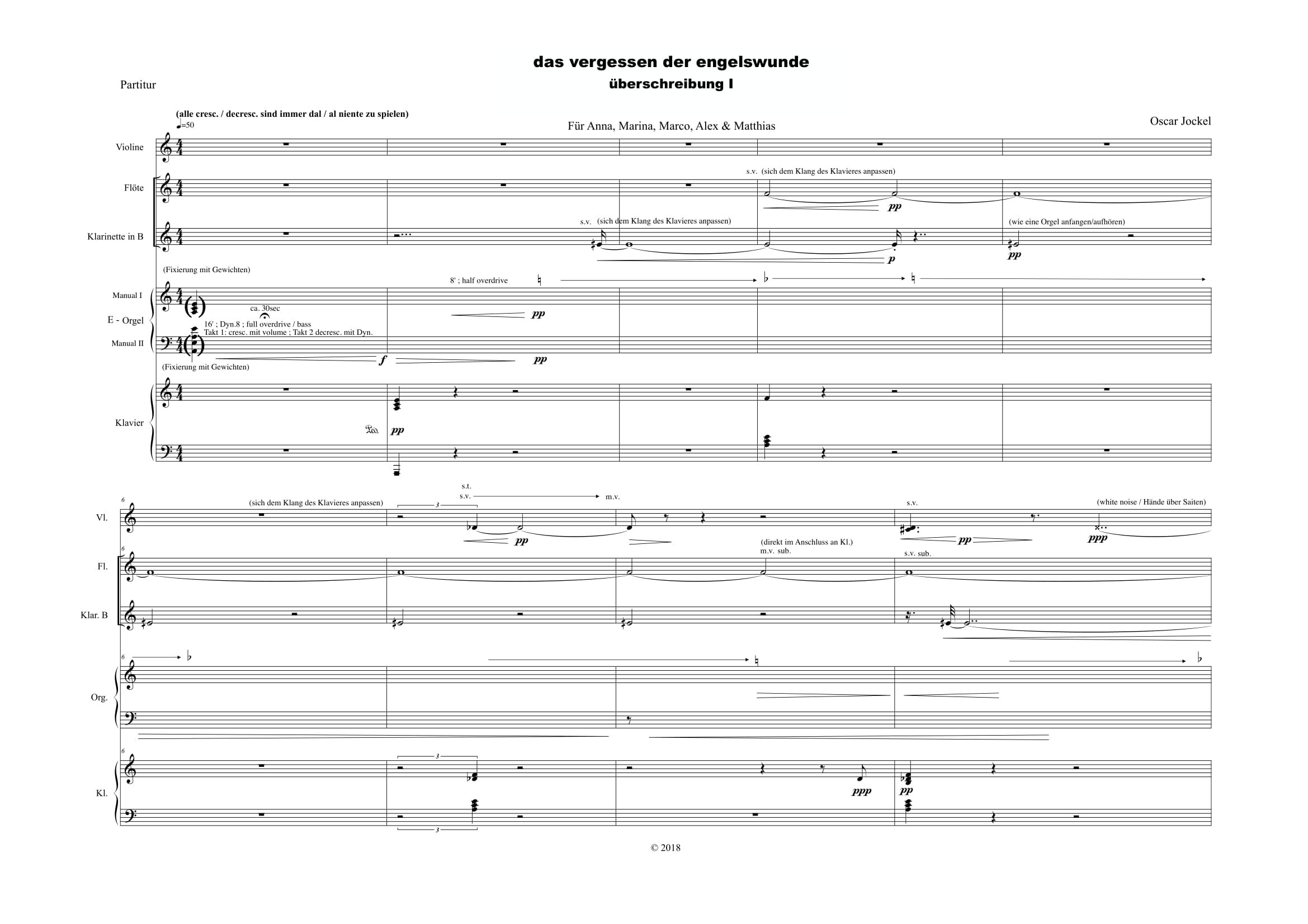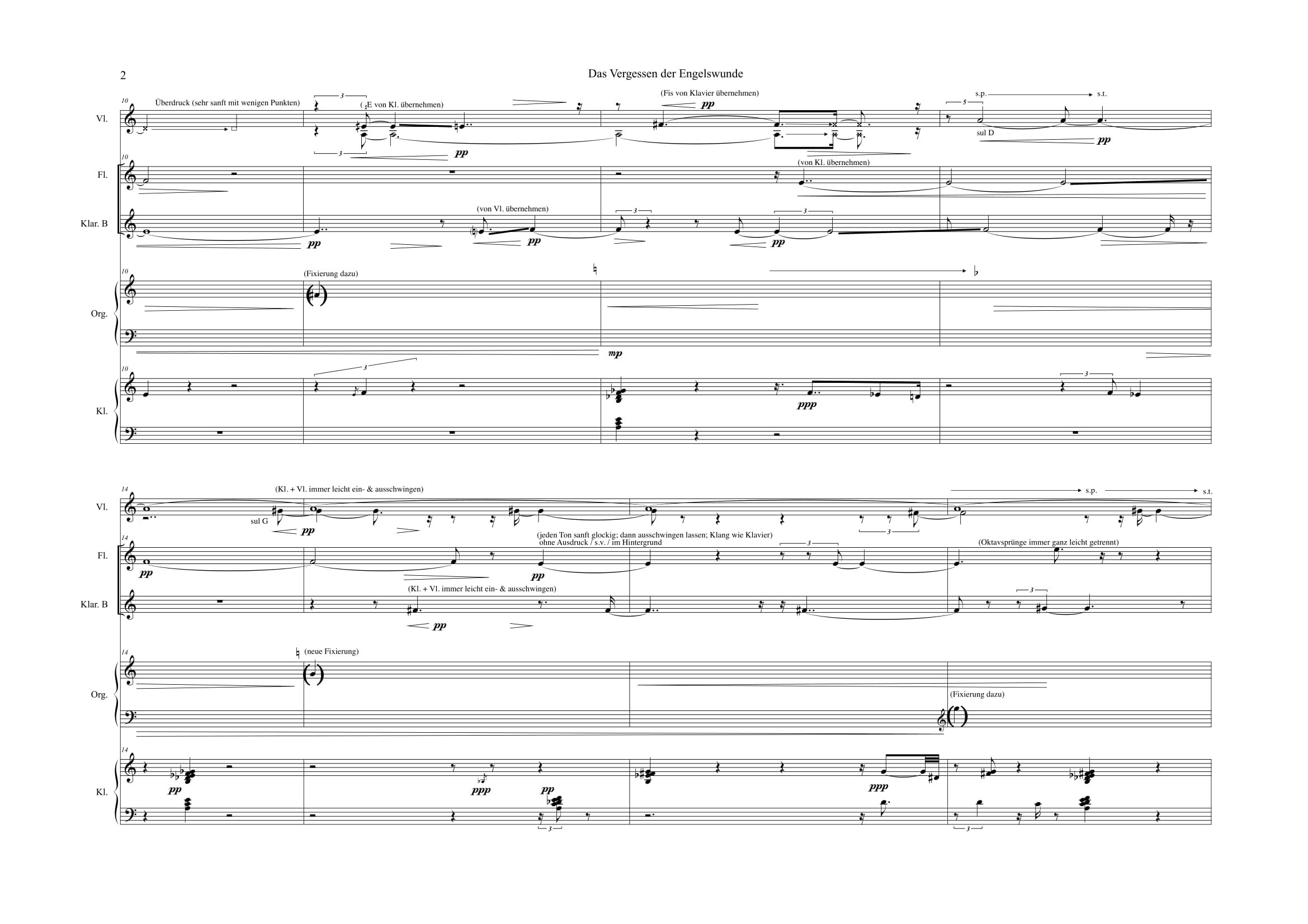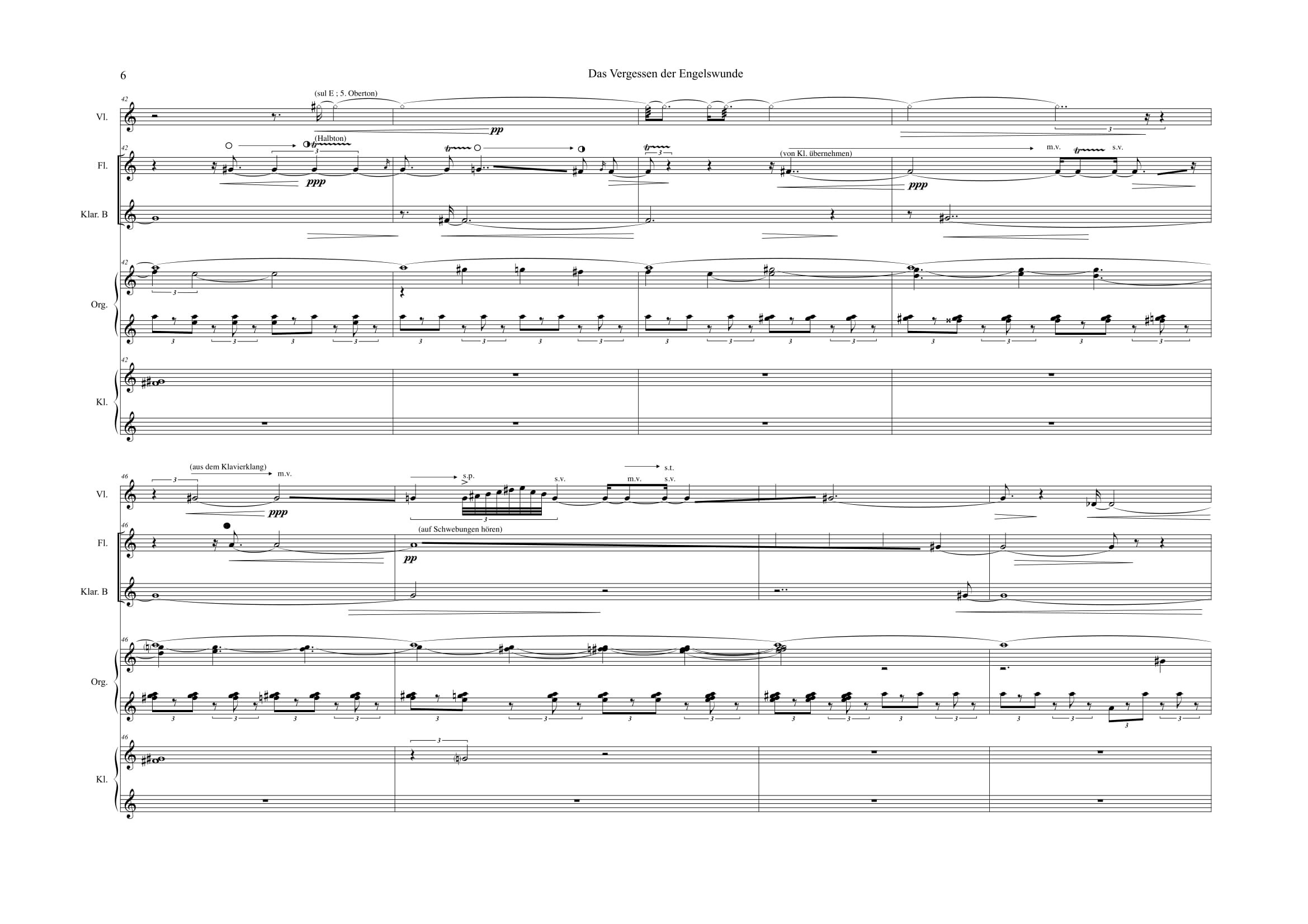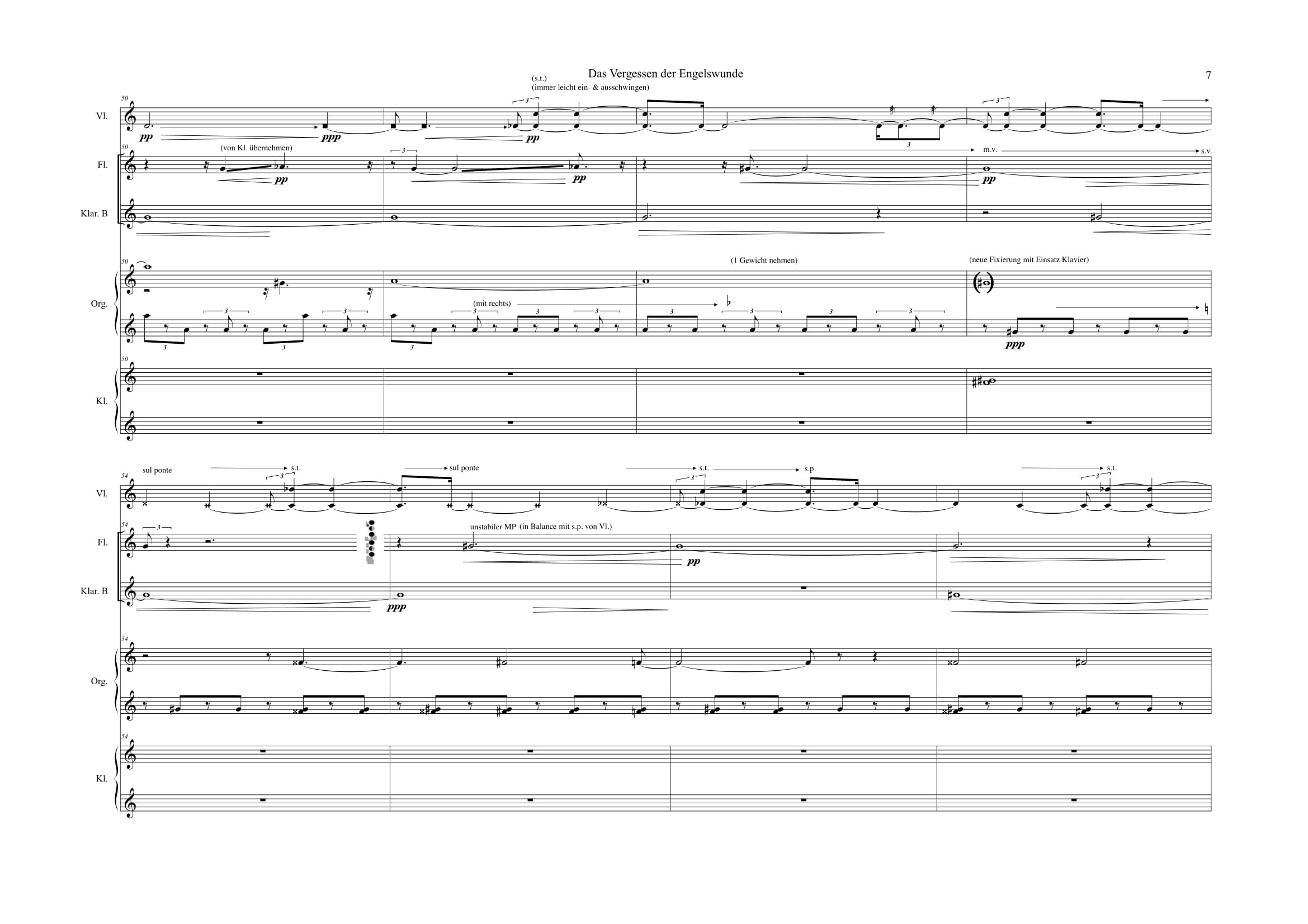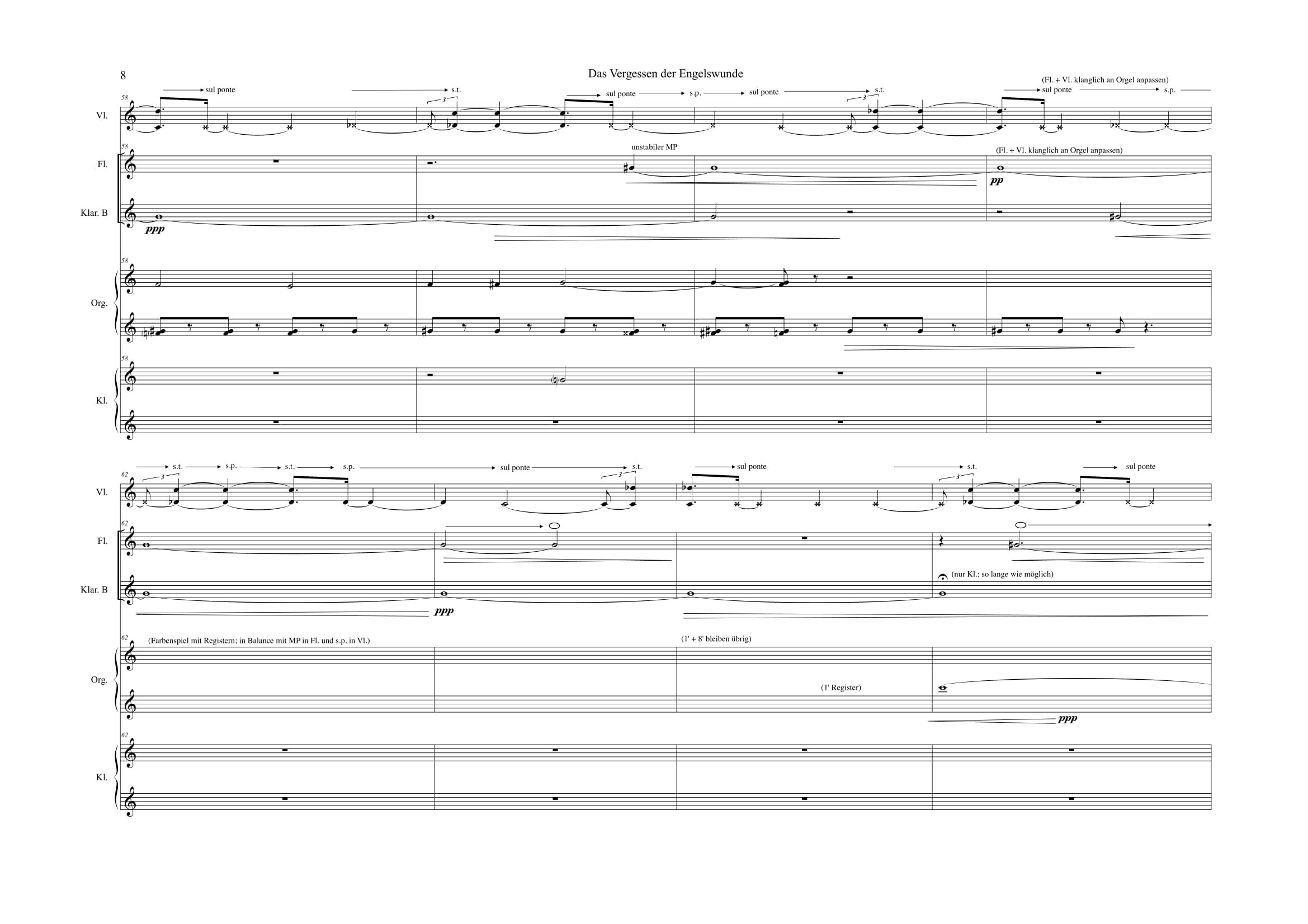das vergessen der engelswunde — overwriting I
[the oblivion of the angel's wound]
for ensemble (2018)
instrumentation: violin, flute, clarinet, e-organ, piano
duration: 8'
premiere: 1/12/2018 in Salzburg, NAMES (New Art and Music Ensemble Salzburg) Anna Lindenbaum (violin), Marina Iglesias Gonzalo (fute), Marco Sala (clarinet), Alexander Bauer (e-organ), Matthias Leboucher (piano)
self-publishing edition: make contact
Text von Rainer Lepuschitz
Dem Kind wird, bevor es in die Welt kommt, vom Engel die gesamte Vergangenheit und die Zukunft, das Paradies und die Hölle gezeigt. Das Kind weiß alles, über seinem Kopf leuchtet ein Licht. Als es geboren werden soll, sträubt sich das Kind, da schlägt ihm der Engel eine Wunde, löscht das Licht über seinem Kopf und führt es in die Welt. Das Kind vergisst alles, was es weiß. Es könnte nicht leben, wenn es wüsste, was geschehen ist und wird.
Eine Legende aus dem Talmud löste in Oscar Jockel die Idee zu der Komposition „Das Vergessen der Engelswunde - Überschreibung I“ aus, die Teil eines Kompositionszyklus ist, in dem es um die Beziehung zwischen Klang und Wahrnehmung geht. Für Jockel heißt „Erinnern eine Bedeutungsbildung, Vergessen einen Bedeutungsverlust“. Wobei der Bedeutungsverlust auch Gewinn sei: Denn Vergessen zu jedem beliebigen Zeitpunkt könnte auch immer ein Neuanfang und Fortschritt sein. Das reine Erinnern hingegen, so Jockel, „wäre ein Entwicklungsstopp. Wenn man sich immer nur an das Gewesene erinnert, bleibt man stehen.“ Was Jockel in Hinblick auf seine Komposition fasziniert, ist der Grenzbereich oder der Übergang zwischen den beiden Extremen des Erinnerns und Vergessens, wobei das musikalische Material vorsichtig abgetastet wird, verschwindet und wieder auftaucht.
Dieser Prozess zwischen Erinnern und Vergessen mache, so Jockel, zu einem Teil auch die europäische Kultur aus. Erkenntnisse wurden geschrieben und wieder überschrieben. Der Palimpsest wäre ein solches Symbol für das überschriebene Vergessene und das neu Geschriebene.
„Das Vergessen der Engelswunde“ für Flöte, Klarinette, Violine, Klavier und E-Orgel ist die erste Komposition in Jockels Zyklus vom Erinnern und Vergessen. Mit beidem hat Musik sehr viel zu tun. Das Hören ist eine Kette von Erinnerungen an das Gehörte. Aber auch wenn das Gehörte der Erinnerung entschwindet, ist es immer noch vorhanden (wie etwa auch das Übermalte und Überschriebene bestehen bleibt, nur nicht mehr sichtbar ist). Dieser Prozess des Vergessens, dem sich Jockel im Zyklus „Überschreibung“ besonders widmet, erscheint ihm paradoxerweise vital: Der Erinnerungsverlust schafft eine neue Bedeutung. Das musikalische Material vom Anfang der Komposition wird mit der Zeit überschrieben. Die Linie des Erinnerns verschwindet mehr und mehr, bis sie sich im Vergessen auflöst.
Als Komponist benutzt er zwar technische Mittel, um das musikalische Material zu durchdringen: „Der Musik bleibt aber ein Geheimnis, das für mich das eigentlich Interessante ist. Ich versuche, mit Hilfe technischer und systematischer Möglichkeiten in der Musik zu verweilen, sie zu präsentieren wie ein Lepidopterologe, der einen schönen Schmetterling entdeckt hat und mit seinen Mitmenschen teilen will.“ Komposition ist für Jockel die Freilegung dessen, was im Klang schon existiert. So wie die Figur, die im Marmorblock eigentlich schon vorhanden ist.
ENGLISH TEXT
Text by Rainer Lepuschitz
Before the child comes into the world, the angel shows it the entire past and the future, paradise and hell. The child knows everything, a light shines above its head. When it is to be born, the child resists, so the angel strikes it a wound, extinguishes the light above its head and leads it into the world. The child forgets everything it knows. It could not live if it knew what has happened in the world and what will happen once on it.
A legend from the Talmud triggered in Oscar Jockel the idea for the composition "the oblivion of the angel's wound - overwriting I", which is part of a cycle of compositions dealing with the relationship between sound and perception. For Jockel, "remembering means creating meaning, forgetting means losing meaning". Whereby the loss of meaning is also gain: for forgetting at any given time could also always be a new beginning and progress. Pure remembering, on the other hand, according to Jockel, "would be a stop to development. If you always remember only what has happened, you stand still." What fascinates Jockel with regard to his composition is the borderline or transition between the two extremes of remembering and forgetting, whereby the musical material is carefully scanned, disappears and reappears.
According to Jockel, this process between remembering and forgetting also constitutes part of European culture. Findings were written and overwritten again. The palimpsest would be such a symbol for the overwritten forgotten and the newly written. "The Oblivion of the Angel's Wound" for flute, clarinet, violin, piano and electric organ is the first composition in Jockel's cycle of remembering and forgetting. Music has a lot to do with both. Hearing is a chain of memories of what has been heard. But even if what is heard disappears from memory, it is still there (just as what has been painted over and overwritten remains, but is no longer visible). This process of forgetting, to which Jockel devotes special attention in the cycle "overwriting", seems paradoxically vital to him: the loss of memory creates a new meaning. The musical material from the beginning of the composition is overwritten over time. The line of remembering disappears more and more until it dissolves into oblivion.
As a composer, he does use technical means to penetrate the musical material: "But there remains a mystery to the music, which is the really interesting thing for me. I try to dwell in the music with the help of technical and systematic means, to present it like a lepidopterist who has discovered a beautiful butterfly and wants to share it with his fellow human beings." For Jockel, composition is the uncovering of what already exists in sound. Like the figure that is actually already there in the block of marble.

